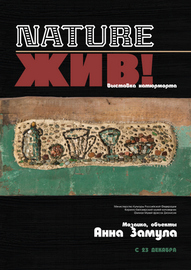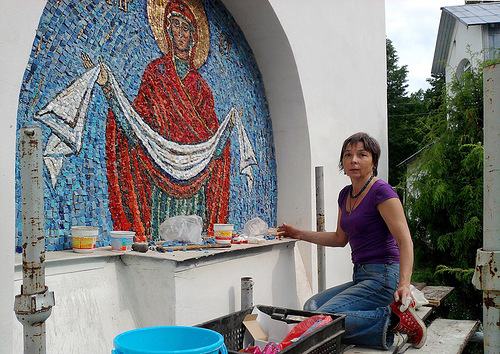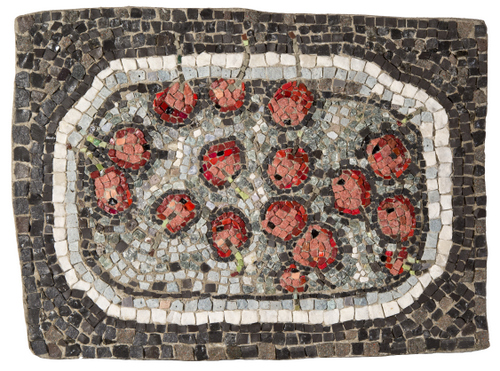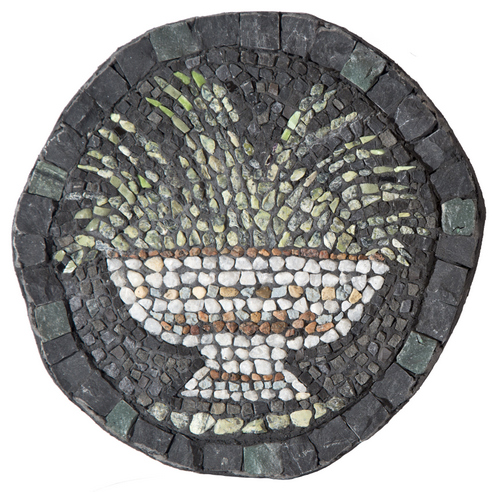 The Museum of Dionisy’s Frescoes presents the display of Moscow artist Anna Zamula “NATURE – LIVE!”. Over 70 mosaics and pictures are about one of the most ancient kind of fine arts – still life. Special attention in the exposition will be paid to mosaic technology (materials, tools) and creative stages of realization of the artistic conception (sketches, preliminary drawings).
The Museum of Dionisy’s Frescoes presents the display of Moscow artist Anna Zamula “NATURE – LIVE!”. Over 70 mosaics and pictures are about one of the most ancient kind of fine arts – still life. Special attention in the exposition will be paid to mosaic technology (materials, tools) and creative stages of realization of the artistic conception (sketches, preliminary drawings).
The exhibition will be open in the Treasury Chamber from December 23, 2014, to February 15, 2015.
“Still lifes (the so-called “nature morte”) transfer information from the time where they were painted to the present in the liveliest and most ingenious way. The depicted subjects that don’t exist any more tell about life and relations of people. Fruit has been eaten long ago, dishes have been broken. But stones that are like fragments of the past are put together and turned into mosaic. And it seems that nothing has happened with them…”
Anna Zamula
Anna Zamula
She was born in Moscow in 1963.
In 1990, she graduated from Moscow Polygraphic Institute (the course of A.V. Vasnetsov).
In 1993, she joined the Moscow Union of Artists.
She had been participating in exhibitions since 1988.
The artist works in the sphere of painting, graphic arts and book illustration.
In 2007, she started to work in the technique of fine-grained mosaic.
Her oeuvres are kept in the New Jerusalem Museum for History, Architecture and Art (Istra), the Tula Necropolis Museum (Tula), the Museum of Music Culture named after M.I. Glinka (Moscow), in private collections in Russia, Germany, Israel, France and the USA.

One-man exhibitions:
1996 - “Invitation to Walk” in the Argus Gallery (Moscow)
1999 - in the Central House of Art Workers (Moscow)
2000 - in the Moscow Cultural Fund (Moscow)
2001 - “Nutcracker” in the ASTI Gallery (Moscow)
2007 - “New Year’s Leaves” in the ART’ERIA Club of the Central House of Art Workers (Moscow)
2009 - “Pictures and Mosaics” at the Cultural Centre “Pokrovsky Gate” (Moscow)
2010 - in the SDM-Bank (Moscow)
2010-2011 - “New Year’s Trees and Dolls” at the New Jerusalem Museum for History, Architecture and Art (Istra)
2011-2012 - “Subject for Small Mosaic” in the editorial office of the magazine “Nashe Naslediye” (Moscow).

Main collective exhibitions:
2003 - at the Frankfurt Book Fair
2006 - “Exhibition of the Association of Russian Artists” (Paris)
2010 - the exhibition of mosaic at the A3 Gallery (Moscow)
2011 - “New Old Materials” in the Russian Academy of Arts (Moscow)
2011 - the exhibition of the association “Kust” titled “Between Past and Present” at the L-Gallery (Moscow)
2011 - “Time to Gather Stones” in the Tula Necropolis Museum (Tula)
2012 - “Moscow Union of Artists-80” in the Central House of Artists (Moscow)
2012 - “Mosaic Art of Russia” in the exhibition all of the Russian Artists’ Union (Moscow)
2012 - the session of Moscow artists at the A3 Gallery (Moscow)
2013 - the exhibition of the association “Kust” at 20 Kuznetsky Most (Moscow)
2013 - the exhibition of muralists at 11 Kuznetsky Most (Moscow)
2014 - the session of Moscow artists at the A3 Gallery (Moscow)
2014 - the exhibition of the association “Kust” at 11 Kuznetsky Most (Moscow).

“Lyricism is the most valuable in art. It will be explained to you in any dictionary that lyricism is sharp and natural sensibility in feelings and spirits. But it is also softness and fineness of the emotional basis…
What is the mosaic of Anna Zamula notable for today? Inventiveness, ingenuity, a particular contact with the material. Easiness and simplicity are important merits of her works. Her compositions are musical; asymmetry of forms is inherent in them. What she depicts is intentionally brought to the fore. Order and clearness reign in her works. It means that order and clearness exist in her mind from the very beginning, or she understands their necessity”.
Grigory Klimovitsky, art critic
“In Anna Zamula’s works, ruberoid like a mosaic module is the basic material and “artistic result”, “physical reality” and a kind of a prototype of the future metaphor at the same time. Flowers and articles of our everyday life are extracted from this ruberoid darkness – pitch and prehistoric. They are visibly tangible, but transparent, shown and doomed to be absorbed in the ruberoid non-existence”.
Valery Panasyuk, art critic







